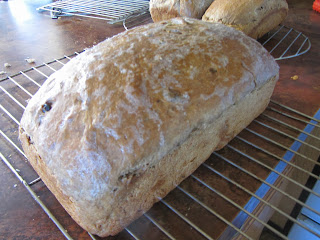How to Get Dough to Rise
I asked Marcia if she had one question about making bread, what would it be.
“How do I get the dough to rise as high as yours does?”
So?
I have potential answers.
1. Tonight, the guys who live here told me that their bread raises the best when it is put above my fridge. There is a small space between the fridge and where cupboard begins, just large enough to fit my bread dough pan. I tried it. It worked. Find such a place in your house. Just a little bit warmer than other places.
2. I usually achieve a warm space by turning a little heat into my oven, then turning the oven off and letting the bread sit there for 30 to 50 minutes. If some other adult lives in your house, you can have a disaster if they turn on the oven to preheat it for cooking they are going to do.
3. I also make sure the bread is in a place where the sun is shining through the window, if I am making it in the winter. In the summer, I take it outside and leave it in the sun but I have to watch it there, for it comes rises so quickly. If I am not ready to proof it in the pans, I just have one of the kids run out and punch it down and then wait until it comes up again. This is not the main reason that I like to show kids how to punch down bread, but when they learn, it is a nice side effect to be able to say to a grandchild, “Will you go punch down the bread” and then they can go do it. I was charmed once seeing Ceilidh do this when she was only about 9 years old.
4. I make sure the dough is soft. Very soft. Marcia reminded me that when we were making the bread with a unit that has a dough hook, that I thought the machine was working too hard and told her to let it work more easily by keeping back the last cup of flour to the last. I guess that would work. All of us have machines with different powers. Know your machine. If the manufacturer has a dough hook and says you can run it 10 minutes, then do so.
5. For sure – let your machine run at leave 5 -6 minutes for white bread and 8-10 for brown bread. Don’t overbeat and let the machine work for 20 minutes. You will undo your good results and your bread will fall.
6. This doesn’t mean you can’t make good bread by hand. Just don’t expect to achieve the same fine textured results that can be achieved with a machine that will mix your dough. Don’t try to replicate all of that mixing of the dough by hand. You have better things to do with your time than knead bread by hand for 8 minutes. I beg you go read or book or have a rest. Just make the dough you are doing by hand, very soft. Very soft. Very, very soft. You have to handle it, so don’t make it so soft that you can’t handle it. Remember the flour hasn’t really absorbed all of that water and in the time that you are letting it raise, it will get drier as it absorbs the liquid. I have been known to just get it into a smooth clump and then leave it. Let the yeast do the work. Nobody is going to reject that bread because its texture isn’t fine enough. A little butter or raspberry jam on the table and it will go as fast as any other loaf.
7. Don’t rush getting at the dough before it has fully risen. Let it rise until it is double in bulk, going to double-and-a-half in bulk. Be patient. You are home for the day anyway. No rush. I used to see my mother’s dough rise and then fall over the sides of the pan. She used to put hers down by the furnace pilot light to get that little bit of extra heat for the bread. She would just scoop it up and punch it down again.
8. I have a recipe that calls for 1 tsp of yeast to make the pizza dough. But you have to let it raise 18 hours. I am telling you this because the yeast will do its work if you leave it long enough. Most bread recipes have enough yeast in there to make the dough rise. We don’t have to wait that long with bread – 18 hours. Usually it is double in bulk by an hour and a bit ... or maybe less.
Did you see any tips there that you can use, Marcia?

























